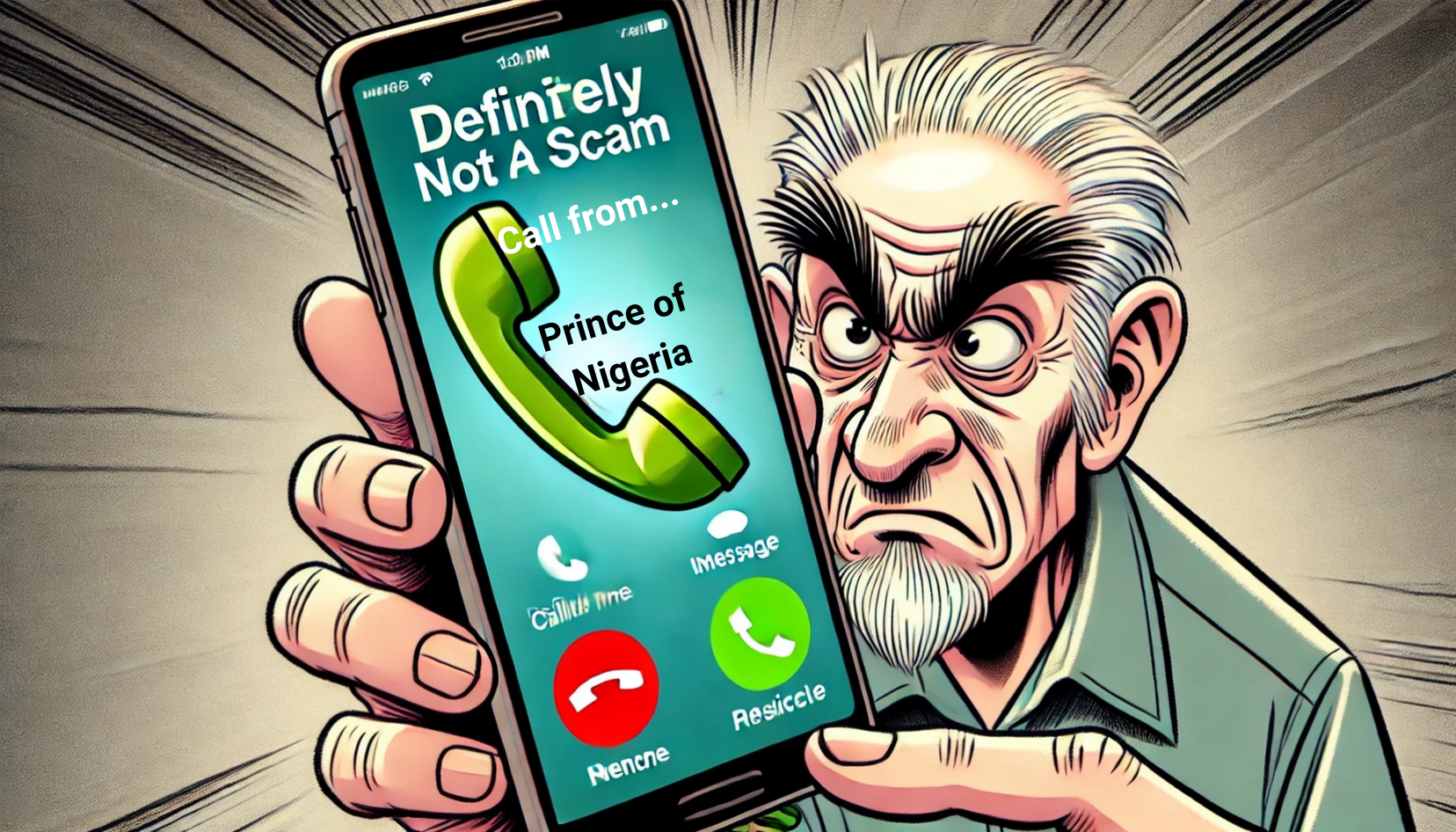
Newsletter Subscribe
Enter your email address below and subscribe to our newsletter


You’d think by now the scammers would have run out of tricks. But like that neighbor who keeps “improving” his house with increasingly questionable DIY projects, scammers just keep getting more creative.
Enter the Wangiri scam – a crafty little number that’s sweeping through phone lines faster than gossip at a high school reunion.
Never heard of it? Neither had most folks until their phone bills suddenly resembled small mortgage payments.
Has this ever happened to you? Your phone rings once, then stops. No message, no nothing. Just a mysterious missed call from a number you don’t recognize.
Your curiosity is piqued. After all, what if it was your doctor’s office? Your grandchild’s school? Ed McMahon rising from the grave to finally deliver that sweepstakes check?
That single unanswered ring might seem harmless – even annoying – but it could be the first step in a scheme designed to separate you from your hard-earned money faster than you can say “Who’s calling, please?“
For seniors especially, these calls represent more than just an annoyance – they’re a direct threat to financial security.
With an increasingly uncertain economy and many are living on fixed incomes and carefully managed retirement funds, unexpected charges can throw a serious wrench into monthly budgets.
Below, we’ll pull back the curtain on exactly how these scammers operate, why they’re targeting seniors specifically, and most importantly – how to protect yourself without having to throw your phone into the nearest body of water (though we understand the temptation).
The good news? With a little knowledge and a healthy dose of skepticism, you can keep these modern-day phone bandits at bay.
So settle in with your favorite beverage as we dive into the strange world of one-ring scams – and emerge scammer-proof on the other side.
Ever receive a call that rings just once before disconnecting? If so, you might have been targeted by what’s known as a “Wangiri” scam.
The term comes from Japan, where these scams first gained notoriety, and literally translates to “one ring and cut.” It’s surprisingly descriptive—like naming your cat “Furball” or your teenager “Sleeps Till Noon.”
The mechanics are devilishly simple. Scammers use automated systems to dial thousands of numbers, allowing each to ring just once before hanging up. It’s like the digital equivalent of ding-dong ditching, except instead of running away giggling, these tricksters are hoping you’ll do exactly what human curiosity often compels us to do: call back to see who was trying to reach you.
“Who could that have been?” you wonder. “Maybe it was important!“
And therein lies the trap, as neat and effective as the old wallet-on-a-string prank from your childhood.
When you return the call, you’re connected to a premium-rate international number—similar to those 1-900 numbers from the 1990s that used to advertise on late-night television (not that any of us would know anything about those).
These numbers typically charge exorbitant connection fees and per-minute rates that would make even your cable company blush. Some scammers enhance the deception by playing pre-recorded messages or background noise to keep you on the line longer, running up charges while you try to figure out who on earth you’ve called.
This scheme first emerged in Japan in the early 2000s as mobile phones became widespread. Clever scammers realized they could exploit international premium-rate number systems and human curiosity to rake in a lot of cash. Like many “successful” scams, it quickly spread worldwide.
The genius—if we can call it that—behind Wangiri is its simplicity.
Unlike complex phishing attempts requiring elaborate fake websites or social engineering, this scam needs only a missed call to trigger our innate desire to know who was trying to reach us.
It’s the telephone equivalent of a mousetrap, with curiosity playing the role of cheese and your wallet as the unsuspecting mouse.
Like spotting a toupee in a windstorm, identifying a Wangiri scam call isn’t too difficult once you know what to look for.
These digital pests have several telltale characteristics that separate them from legitimate calls you might actually want to receive.
First, there’s the signature “one-ring wonder” pattern. Your phone rings briefly—just long enough to register as a missed call—then abruptly stops.
The calling numbers typically sport area codes you don’t recognize. They might resemble domestic numbers but often come from international locations with expensive connection rates.
Popular prefixes include 268 (Antigua), 876 (Jamaica), 473 (Grenada), and 649 (Turks and Caicos)—lovely places to visit, perhaps, but not where your dentist or grandkids are likely calling from.
Watch for what’s missing, too. Legitimate callers generally leave voicemails or send text messages if they can’t reach you.
Wangiri scammers do neither—they’re fishing for callbacks, not conversation. It’s like receiving a mysterious empty envelope in the mail; the absence of content is itself suspicious.
Be especially wary if you receive multiple missed calls from different yet similar-looking numbers. This suggests an automated system working through various numbers to hook you—the digital equivalent of throwing multiple fishing lines into the same pond.
Remember: legitimate businesses, healthcare providers, and loved ones will leave messages explaining why they called. A true emergency won’t present itself as a mysterious single ring from the Bahamas.
Falling for a Wangiri scam isn’t just annoying—it can hit you where it hurts most: your wallet and your peace of mind.
Remember when long-distance calls were so expensive your parents set a kitchen timer while you talked to your cousin in Cleveland? Wangiri scams make those rates look like bargain-basement deals.
Just calling these premium rate numbers can cost $5 to $30, with per-minute fees stacking up faster than junk mail on the kitchen counter. Some unlucky folks have opened their phone bills to find hundreds of dollars drained from a call that lasted less time than it takes to find your reading glasses.
Call back, and you might find yourself in a friendly little chat—except the person on the other end isn’t your long-lost cousin. They’ll stall with small talk, ask innocent-sounding questions, or dangle a fake prize in front of you. Before you know it, you’ve spilled personal details they can use for identity theft or more scams down the road.
It’s like handing your house keys to someone just because they complimented your garden.
Maybe the cruelest part of these scams isn’t the money—it’s the anxiety they create. For many seniors, a missed call isn’t just a missed call.
It’s What if it was my doctor? Was it about my prescription? Is a family member in trouble?
Scammers know this, and they exploit your caring nature and sense of responsibility.
Even after you realize it was a scam, the stress doesn’t just vanish. You might start second-guessing every unfamiliar call, worrying about your phone bill, or feeling embarrassed for being targeted.
Don’t.
These scammers aren’t picking on you personally—they cast a wide net, hoping to catch anyone in a moment of concern or distraction. Even the sharpest people can get snagged.
Protecting yourself from Wangiri scams is fairly simple. Here are some practical steps to keep these phone bandits at bay:
When it comes to strange numbers, treat them like that mysterious leftover container in the back of your fridge—just leave it alone!
If a number rings once and you don’t recognize it, fight the urge to call back. Your curiosity isn’t worth the surprise charges that could show up on your next phone bill.
Your smartphone has more protective features than Fort Knox—you just need to use them:
Most modern phones can screen and identify potential spamSpam refers to unsolicited or unwanted messages, often sent in bulk, typically via email, text messa... More calls. Look in your phone settings for “Call Blocking & Identification” (iPhone) or “Caller ID & Spam Protection” (AndroidAndroid is a type of operating system—like the brain of a device—that runs on many smartphones a... More). Enable these features and let your phone do the heavy lifting.
Send unknown callers straight to voicemail by toggling on the aptly named “Silence Unknown Callers” feature. If it’s important, they’ll leave a message. If it’s a scammer, they won’t bother.
There are apps out there that claim to help block scam calls. Some work by screening incoming numbers against databases of known scammers, warning you or even blocking the calls automatically.
We haven’t tested them ourselves, so we can’t say for sure how well they work. But if you’re interested, it might be worth looking into. Think of them as an extra layer of defense—like a peephole for your phone.
Knowledge, as they say, is power—and now you’ve got the upper hand. Wangiri scammers are counting on two things: your curiosity and your good nature. But now that you know their game, you’ve already taken away their biggest advantage.
You can also help protect others. Spread the word. Mention it at book club, over coffee, or during your next bridge game. Forward this to that sibling who still thinks every call must be answered.
The more people who recognize these scams, the less they’ll work. Think of it as neighborhood watch—just for your phone.
Scammers may be sneaky, but they’re no match for an informed community that knows their tricks.
So next time your phone rings once and goes silent, just smile, ignore it, and get back to enjoying your day—scam-free. Because the best way to handle a scam isn’t outrage or worry. It’s the quiet satisfaction of not taking the bait.
As the old saying goes, “Fool me once, shame on you. Fool me twice… not happening.”